How to learn more about computers
This page is for anyone interested in learning more about their computers and are unsure where to begin. Because computers are complex machines, we've designed this page to be a quick reference and a complete overview of everything relating to them. On this page, you'll find links to others that go into more depth about each subject.
If you only need a quick overview of the computer in general, see our computer definition.
What makes the computer work?
Transistors

The computer contains millions of transistors, which are the primary building block of all microchips, including your CPU (central processing unit).
When placed in different configurations, transistors form logic gates, which can combine into arrays called half adders that also combine into full adders. It is what creates the machine language your computer uses to communicate and deal with Boolean logic.
Machine language

All computers and electronic devices communicate in binary, several 0's and 1's or Off and On electrical signals. All software written on your computer is created in a high-level programming language that humans can understand. When complete, the program is compiled to a low-level machine language that computers understand.
ASCII codes
Each binary 0 or 1 is considered a bit, and each number, letter, or other character is made up of eight bits (one byte). A common method for storing and editing text is done with ASCII codes, which is one byte of binary. For example, the lowercase letter "a" has an ASCII (American Standard Code for Information Interchange) code decimal value of 97 or 01100001 in binary.
Unicode
ASCII only supports 256 characters, which is not enough characters for many languages and to represent all of the symbols used with computers. To help solve this problem, Unicode was created. The 16-bit version of Unicode for example has enough space for over one million characters.
Memory
Computer memory is any physical device capable of storing information temporarily. For example, the computer memory RAM (random-access memory) is a volatile memory that stores running applications. When the computer is turned off, all data in the memory is lost.
Storage
Because computers cannot be on all the time, they need to store information. A non-volatile type of memory like a hard drive is what stores information even when the computer is turned off. Information stored on the computer is stored as a file; a file is a document, movie, photo, music, or other file types. These files are stored in a storage device.
It's very common for new computer users to confuse memory and storage. However, these are different types of memory. Your computer always has less memory than storage.
Over the evolution of computers there were different media types and technologies that store data. Below is a listing of some storage devices from oldest to newest.
- Punch card
- Punch tape
- Hard drive
- Tape drive
- Floppy diskette
- Zip disk
- CD (compact disc)
- DVD (digital versatile disc)
- Blu-ray disc
- Flash jump drive
- SSD (solid-state drive)
- NAS (network access server)
- Cloud Storage
See our storage device page for complete information about storage devices.
Memory and storage capacity
All memory and storage have a total capacity that's written using abbreviations like KB (kilobyte), MB (megabyte), GB (gigabyte), and TB (terabyte). See the following link for a complete understanding of all values.
Cache
Another faster type of memory is called cache. Cache memory is a smaller portion of memory kept on or near the CPU to store recently accessed portions of memory. When the CPU needs information, if it's in the cache it's loaded from cache almost immediately instead of having to wait for the slower RAM.
ROM
Another type of memory, ROM (read-only memory), is a memory chip with data that can only be read. Most computers today have a PROM (programmable read-only memory), which is still read-only but can be re-programmed if needed through a firmware update.
Input and output
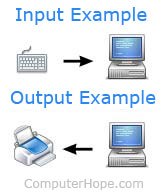
Humans use input devices, such as a keyboard and a mouse, to interact with a computer. Computers can also receive input from sensors. The computer processes that inputted data and then sends the modified or new information to an output device, such as a monitor. The printer is another output device that can produce a hard copy of documents and pictures stored on the computer. The process of inputting and outputting information is called input/output, or the I/O process.
Hardware and software
Software is instructions and code installed into the computer, like the Internet browser you're using to view this page. Hardware is a physical device you can touch, like the monitor or screen you're using to read this page.
Computer hardware
CPU
The CPU (central processing unit) or processor handles all instructions it receives from hardware and software running on the computer. In the CPU, there are two primary components.
- ALU (arithmetic logic unit) - performs mathematical, logical, and decision operations.
- CU (control unit) - directs all the processors operations.
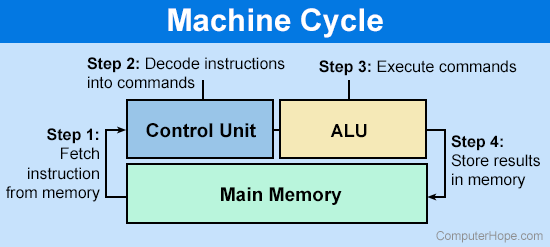
Motherboard
The motherboard is the largest circuit board in the computer case that holds and connects everything together. Without the motherboard, components like your processor and memory could not communicate with each other. Below is an example of a desktop computer motherboard.
Expansion cards
An expansion card is a card added to the computer to give it additional capabilities. A video card, modem, network card, and sound card are all examples of expansion cards. Each expansion card can have a different type of connector (e.g., AGP (accelerated graphics port), PCI (peripheral component interconnect), PCIe (PCI Express)) to communicate with the motherboard.
For some laptops, additional cards are added into the PC Card slot.
Computers may also have onboard devices, such as onboard sound and network capabilities built onto the motherboard.
Drives
A computer has one or more drives. Almost all computers have a hard drive but may also have a disc drive and connect other removable drives like flash drives.
There are diskless workstations that have no drives.
Peripherals
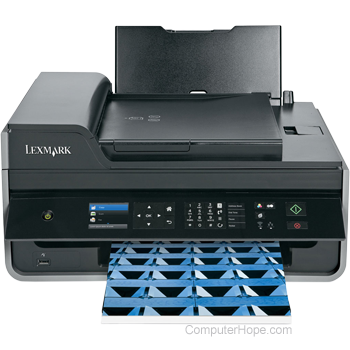
Computer peripherals are hardware that's not required by the computer and are connected to a computer after it's purchased. Peripherals give the computer additional abilities. For example, a printer is a good example of a peripheral. Today, most peripherals are connected to a computer using USB; however, over the evolution of the computer, there were many different connections.
Computer software
Operating system
Every computer must have an operating system for software to communicate with the hardware and user. For example, most IBM-compatible computers run the Microsoft Windows operating system and can also run operating systems like Linux. Apple computers only run macOS.
Today, most users use a GUI (graphical user interface) operating system like Windows because of its ease of use. However, in the past, there were only command line operating systems, which require users to type instructions for every action. Although GUI is the most common user interface, many people still use the command line today, especially when connecting to a computer remotely.
Programs
A computer would work fine with only an operating system. However, most users want to do more with their computer. Programs (applications) can be installed that allow a user to do almost anything. For example, a word processor could be installed to write letters, and a spreadsheet could keep track of expenses.
For a full list of computer programs and their categories, see our programs page.
Files
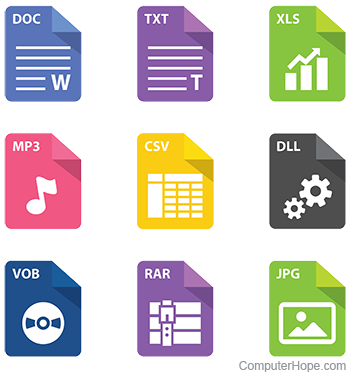
The operating system, programs, and its data is stored as a file. Each file type has different abilities and is identified on a PC using file extensions. When a computer file is opened, the computer looks at the file type and performs an action or runs the program associated with that file type. For example, a .exe file is an executable file that runs a program, and a .txt file is a text file that may open in Notepad.
Files are stored on drives and organized by storing related files in folders. These folders and files are browsed using a file manager such as file explorer. To make it easier to find and access programs on the computer, shortcuts are created with icons of the program. These shortcuts can be placed anywhere on the computer, including the desktop and Taskbar.
Programming

All software running on a computer was created using a programming language by a computer programmer. Programming allows a person or company to design custom programs or instruct a computer to do almost anything imaginable.
Networks and the Internet
Network
A computer network allows a computer to communicate (talk) with other computers. There are two primary types of networks: a LAN (local area network) like a home network and a WAN (wide area network) like the Internet.
Computers communicate using a NIC (network interface card) or wirelessly with Wi-Fi that connects a computer to a router or a switch that connects to a router.
To communicate with the router and other computers and network devices, a protocol is used by all devices. For example, the TCP/IP protocol is a good example of a network protocol.
Internet
The Internet is a world-wide network that connects billions of computers and other networking devices. The WWW (World Wide Web) on the Internet is explored using a browser to browse different websites created using HTML (hypertext markup language). From the Internet, you can find anything with search engines, download software, send e-mail, connect with social networking, watch movies, and more.
Familiarize yourself with the computer jargon

It would be impossible to know every computer-related term. However, familiarizing yourself with the top computer-related terms is another great way to learn more about computers.
Computer history
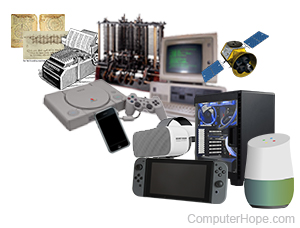
The history of computers and how they have progressed over the years is another great way to get a better understanding of computers. We've listed several thousand key events in our computer history section and list hundreds of computer pioneers who have made the computer industry what it is today.
How to keep up-to-date on computers
Computers and their hardware and related software are constantly evolving. Try to keep as up-to-date as possible by reading computer-related news, blogs, RSS feeds, newsletters, forums, and following computer people on social networking sites, like Twitter.
Computer quiz
Ready to test yourself, your computer skills, and learn more about computers at the same time? Take the Computer Hope quiz, which contains hundreds of computer-related questions. After each question is answered, a brief description of the answer is given, and additional information and related links. When completed, you get a complete overview of what categories you may need to improve and learn more about with links to where you can find that information.
Where else to learn about computers
Free college courses
Many big colleges and universities have posted free online courses that anyone can watch, covering various computer-related topics. Watching these online can give you a similar education to what you may get by going to school.
Online free books
There are hundreds of thousands of online computer books and computer-related e-books to download. See the eBook definition for a full listing of places to find books online for free and legally.

